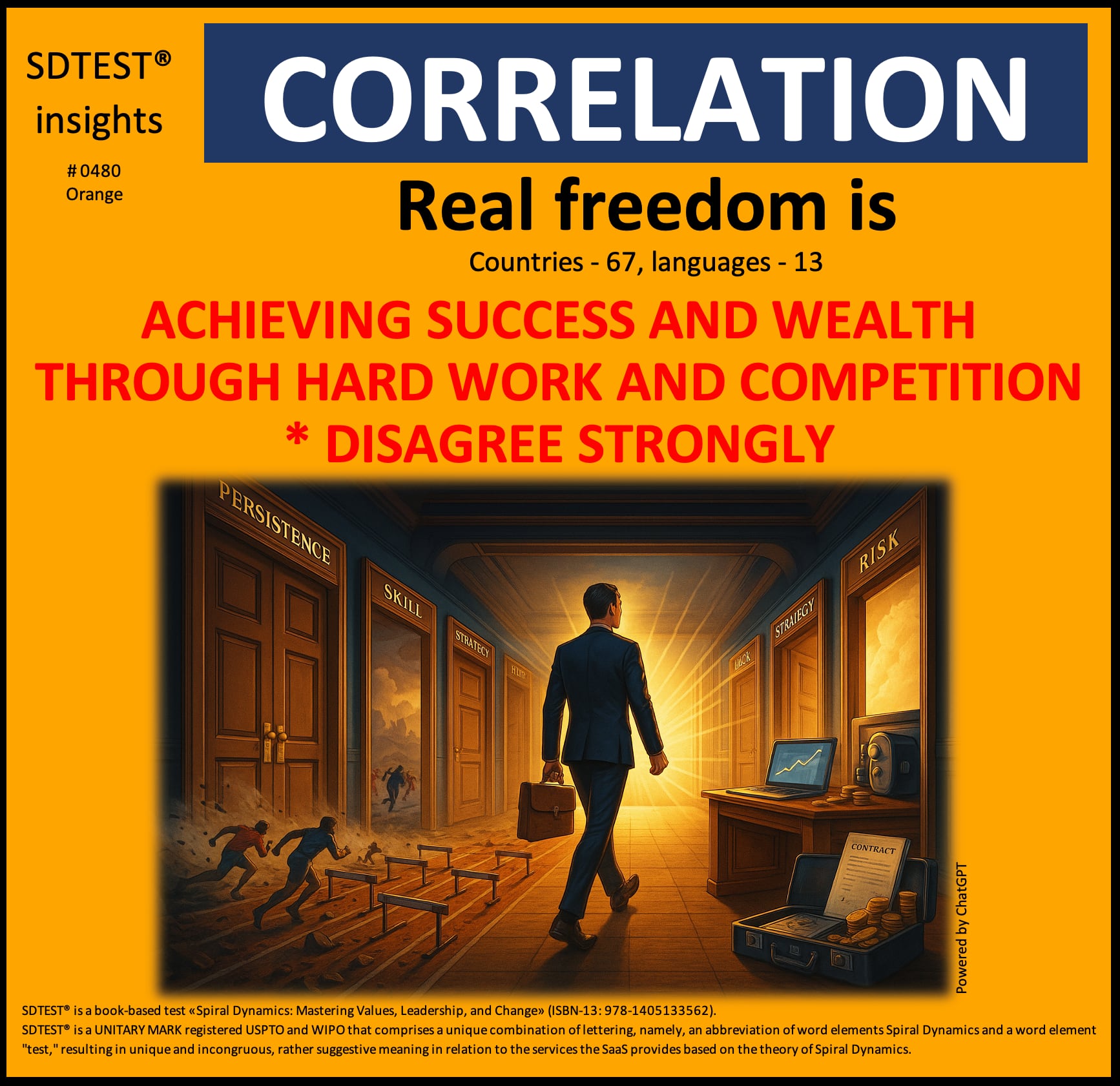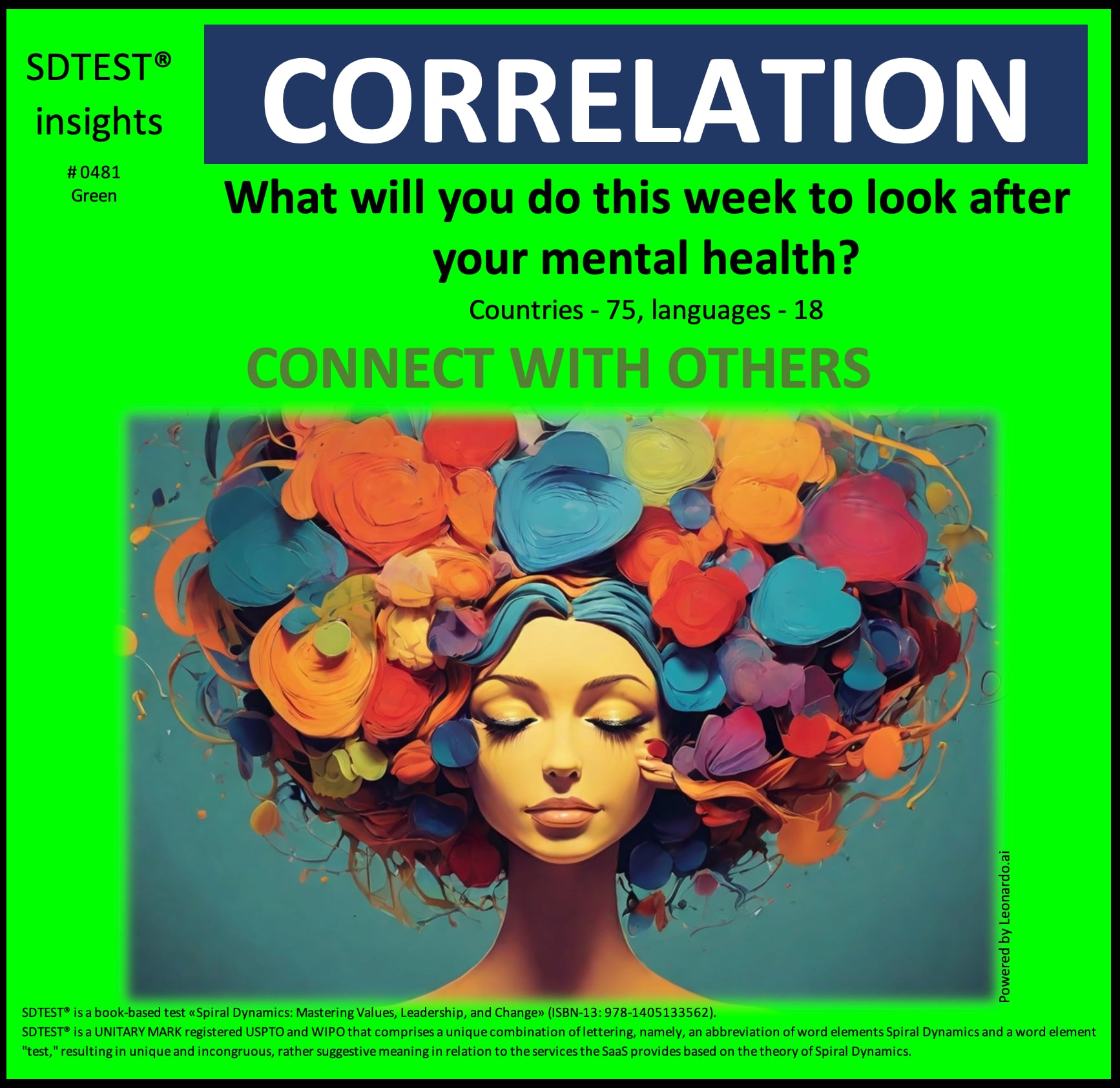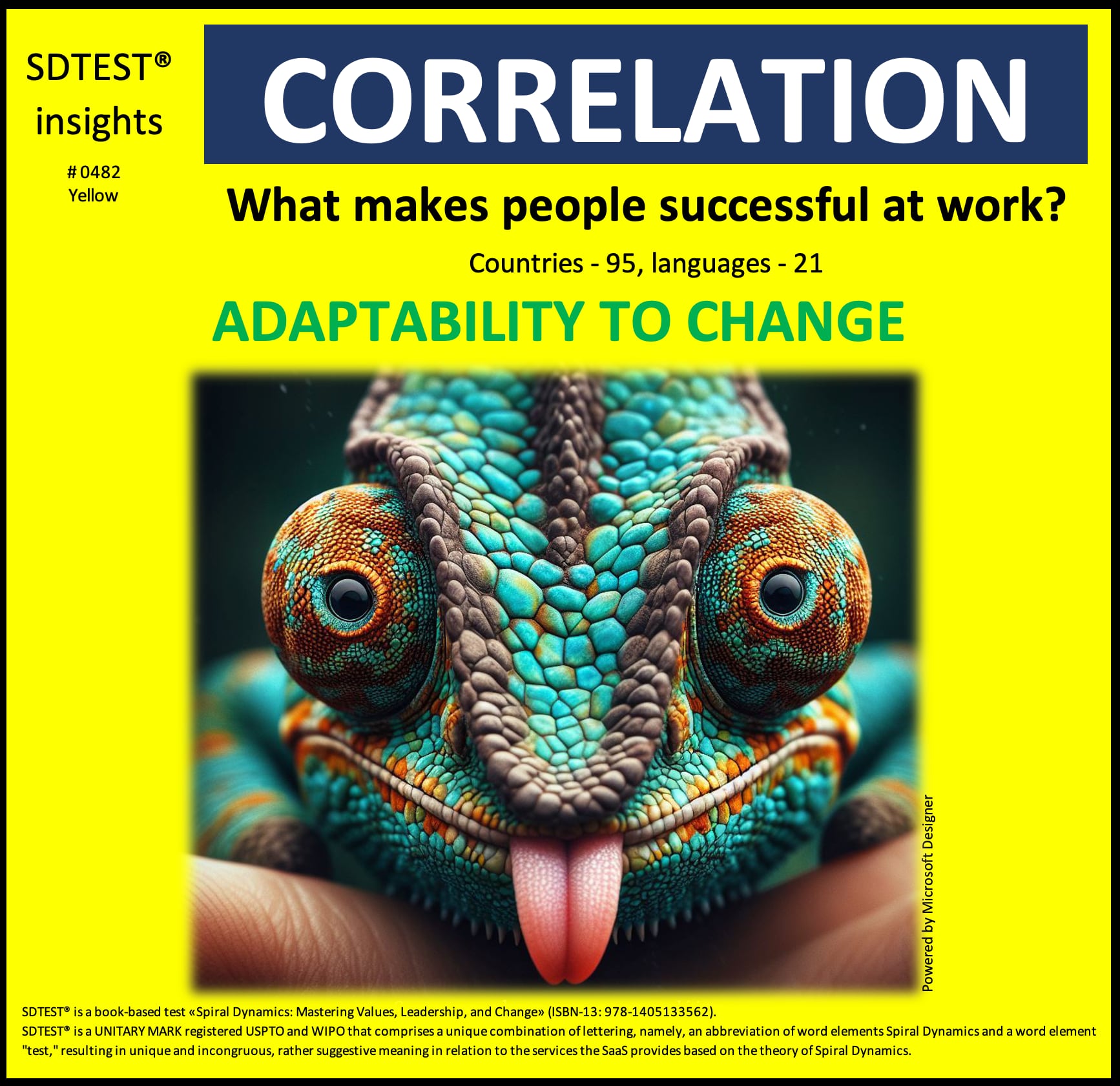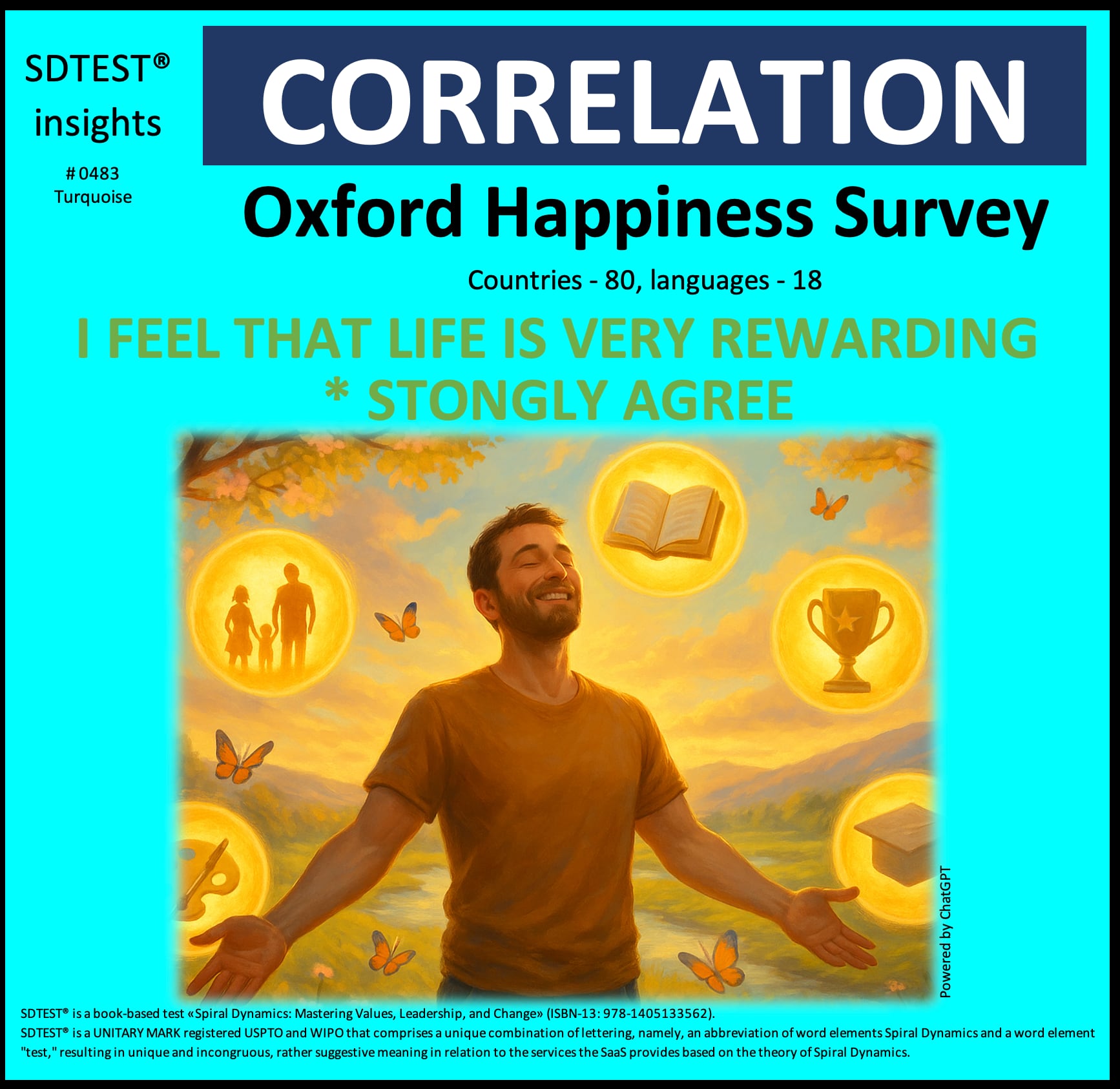SDTEST® has 38 different VUCA polls that calculate the 13,643 correlation values between stages of development according to the theory of Spiral Dynamics and answer options of these 38 polls.
We invite curiosity about the systemic mechanisms behind this correlation. There may be hidden variables that provide alternative explanations.
In our analysis of the poll "What makes a boss a great leader?" we found an intriguing positive linear correlation that warrants closer examination:
0.0182 (Pearson) between the Empathy and the Purple stage.
The critical value of the correlation coefficient for a non-normal distribution, by Spearman, is r = 0.0016. Nevertheless, this positive linear correlation of 0.0182 meets the reliability criteria but does not necessarily imply causation.
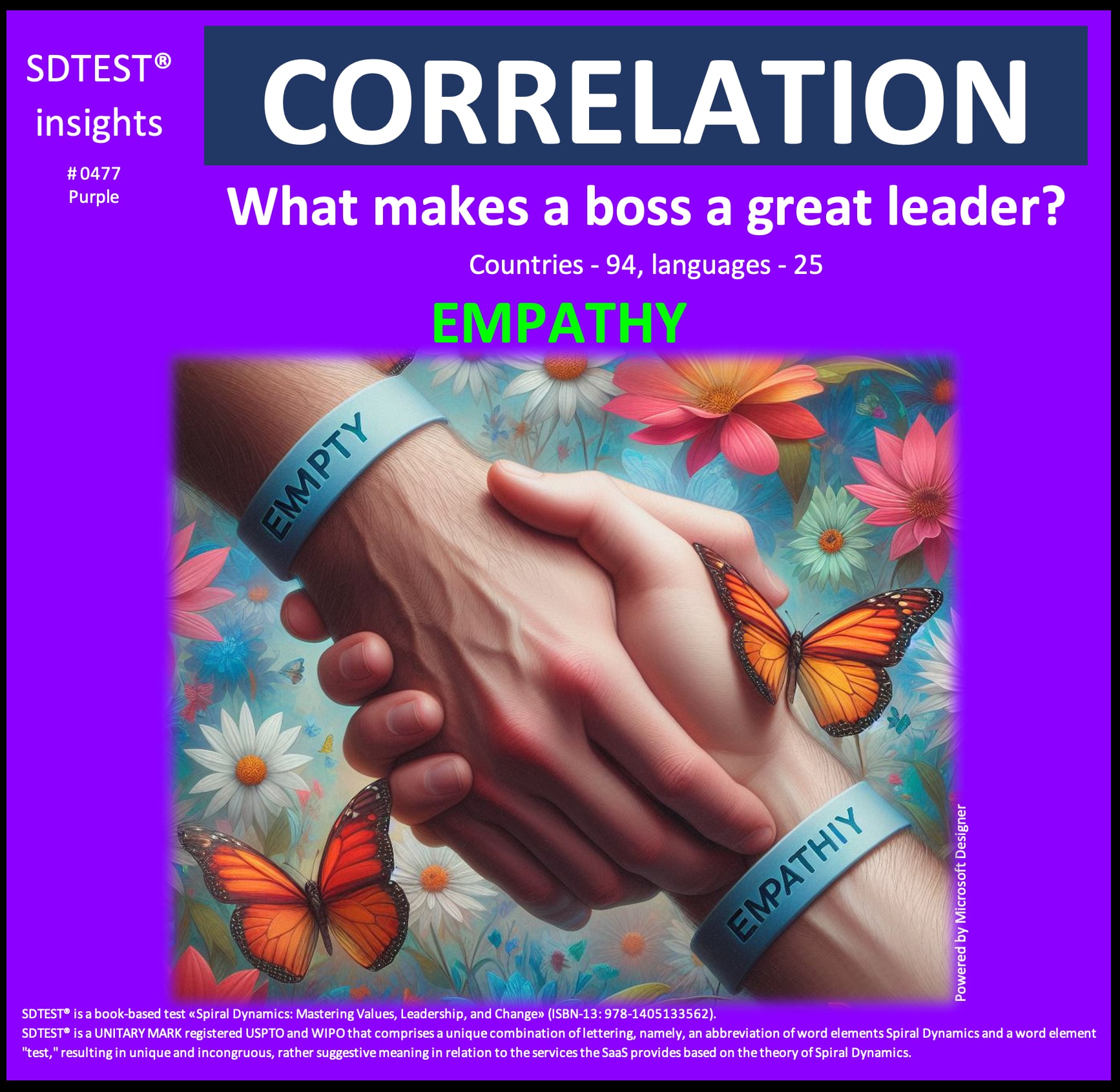
This positive correlation of 0.0182 between Empathy as a leadership quality and the Purple stage offers meaningful insights when viewed through the lens of the Purple value system:
Organizational Perspective:
Organizations operating within the Purple mindset might interpret this correlation as:
- Validation of their belief that leaders must understand and honor the spiritual and emotional needs of their tribal community.
- Confirmation that their traditional approach values leaders who can sense and protect against unseen threats to the collective.
- Evidence supporting their belief that empathic leaders better preserve and transmit ancestral wisdom and sacred practices.
These organizations might respond by:
- - Developing rituals that honor and celebrate empathic leaders who protect the tribe's traditions.
- - Implementing selection processes that identify leaders with strong intuitive connections to the group's spiritual needs.
- - Promoting leadership development through mentorship by respected elders who embody empathic wisdom.
Team Perspective:
Teams operating from a Purple mindset might approach this correlation by:
- Viewing it as an affirmation that empathic leaders better maintain harmony and cohesion within their sacred circle.
- Interpreting it as supporting their need for leaders who can sense when team members are out of alignment with tribal values.
- Seeing it as validation for their preference for leaders who intuitively understand unspoken fears and collective anxieties.
These teams might respond by:
- Engaging in communal ceremonies that strengthen empathic bonds between leaders and followers.
- Encouraging team members to seek guidance from empathic leaders during times of uncertainty or transition.
- Celebrating instances where leader empathy helped maintain tribal safety and traditional practices.
Individual Perspective:
Individuals aligned with the Purple value system might interpret this correlation as:
- Personal validation of their belief that true leaders can sense and respect their connection to ancestors and traditions.
- Evidence supporting their experience that empathic leaders provide better protection from unknown dangers.
- Confirmation of the value they place on leaders who understand their need for belonging and meaning.
These individuals might respond by:
- Actively seeking protection and guidance from leaders who demonstrate empathic understanding of tribal values.
- Viewing empathic leaders as more likely to be blessed by ancestral spirits or divine forces.
- Using a leader's empathic capacity as evidence of their legitimate authority within the tribal structure.
This correlation, viewed through the Purple lens, suggests that those operating at the Purple level recognize empathy as a sign of a leader's connection to deeper spiritual forces. It implies that the Purple value system's focus on tradition, community bonds, and supernatural protection aligns with valuing empathic leadership qualities.
The reasons why Empathy might be seen as a crucial leadership quality in the Purple stage could include:
- Spiritual Connection: Empathy represents a leader's ability to sense and interpret spiritual forces affecting the tribe.
- Collective Safety: It enables leaders to intuitively detect threats to the group's physical and spiritual well-being.
- Traditional Wisdom: Empathic leaders can better honor and preserve sacred traditions and ancestral knowledge.
- Tribal Bonding: It strengthens the mystical connection between leaders and followers as part of the same spiritual family.
- Ceremonial Effectiveness: Empathic leaders can better guide rituals and ceremonies that maintain cosmic harmony.
This correlation prompts us to consider how different value systems approach empathy in leadership. It raises questions about the potential benefits of empathic leadership in contexts where collective identity, traditional wisdom, and spiritual safety are paramount concerns.
Ultimately, this correlation highlights the complex interplay between spiritual beliefs, tribal identity, and leadership effectiveness. Empathy in Purple-dominant environments may be seen not merely as an interpersonal skill but as evidence of a leader's sacred connection to the tribe's deeper spiritual foundations.
In our analysis of the poll "Where would be your next most exciting opportunity?" we found an intriguing positive linear correlation that warrants closer examination:
0.0316 (Pearson) between the In a Start up / Scale up! and the Red stage.
The critical value of the correlation coefficient for a non-normal distribution, by Spearman, is r = 0.0022. Nevertheless, this positive linear correlation of 0.0316 meets the reliability criteria but does not necessarily imply causation.

This positive correlation of 0.0316 between "Start up / Scale up" as an exciting opportunity and the Red stage offers compelling insights when viewed through the lens of the Red value system:
Organizational Perspective:
Organizations operating within the Red mindset might interpret this correlation as:
- Validation of their aggressive, power-driven approach to market conquest and business development.
- Confirmation that their bold, rule-breaking culture enables the rapid growth that startups require.
- Evidence supporting their belief that hierarchical power structures with dominant leaders drive success.
These organizations might respond by:
- Developing even more aggressive growth strategies that prioritize dominance over sustainability.
- Implementing reward systems that favor those who conquer new markets regardless of the methods used.
- Promoting leadership styles that emphasize personal power, immediate results, and competitive victory.
Team Perspective:
Teams operating from a Red mindset might approach this correlation by:
- Viewing it as affirmation that their fierce, competitive team dynamic drives startup success.
- Interpreting it as supporting their belief that startups thrive when team members fight to prove their value.
- Seeing it as validation for prioritizing bold action and immediate results over careful planning.
These teams might respond by:
- Engaging in more territorial behaviors to secure resources and recognition within the startup.
- Encouraging team members to assert their dominance and fight for their ideas and projects.
- Celebrating instances of individual heroics and dramatic wins that demonstrate personal power.
Individual Perspective:
Individuals aligned with the Red value system might interpret this correlation as:
- Personal validation of their aggressive and assertive approach to career advancement.
- Evidence supporting their belief that startups offer the best environment to achieve personal power.
- Confirmation of the value they place on immediate rewards and freedom from constraining rules.
These individuals might respond by:
- Actively seeking startup opportunities that promise quick advancement and minimal oversight.
- Viewing startups as battlegrounds where they can demonstrate their strength and dominance.
- Using startup environments to build personal empires and gain recognition for individual achievements.
This correlation, viewed through the Red lens, suggests that those operating at the Red level are naturally drawn to startup environments. It implies that the Red value system's focus on power, impulsiveness, and immediate gratification aligns perfectly with the dynamic, unconstrained nature of startup culture.
The reasons why a Start up / Scale up might be seen as the most exciting opportunity in the Red stage could include:
- Power Acquisition: Startups offer rapid paths to personal power and influence without established hierarchies.
- Freedom from Constraints: Unestablished rules and procedures allow for uninhibited self-expression.
- Immediate Rewards: The potential for quick wins and rapid growth satisfies desires for immediate gratification.
- Heroic Recognition: Startups create opportunities for visible, dramatic achievements that earn respect and fear.
- Competitive Arena: The high-stakes environment provides a perfect battleground to demonstrate dominance.
This correlation prompts us to consider how different value systems approach career opportunities. It raises questions about Red energy's potential benefits and drawbacks in startup environments, particularly in contexts where sustainable growth and collaborative innovation are crucial.
Ultimately, this correlation highlights the complex interplay between individual motivation, team dynamics, and organizational success. The startup world might be particularly attractive to Red-dominant individuals precisely because it rewards bold action, risk-taking, and the aggressive pursuit of opportunities.
In our analysis of the poll "Ageism’s causes," we found an intriguing positive linear correlation that warrants closer examination:
0.1410 (Pearson) between the No, interpersonal interactions do not reflect broader social attitudes, and the Blue stage.
The critical value of the correlation coefficient for a normal distribution, by William Sealy Gosset (Student), is r = 0.0829. Nevertheless, this positive linear correlation of 0.1410 meets the reliability criteria but does not necessarily imply causation.
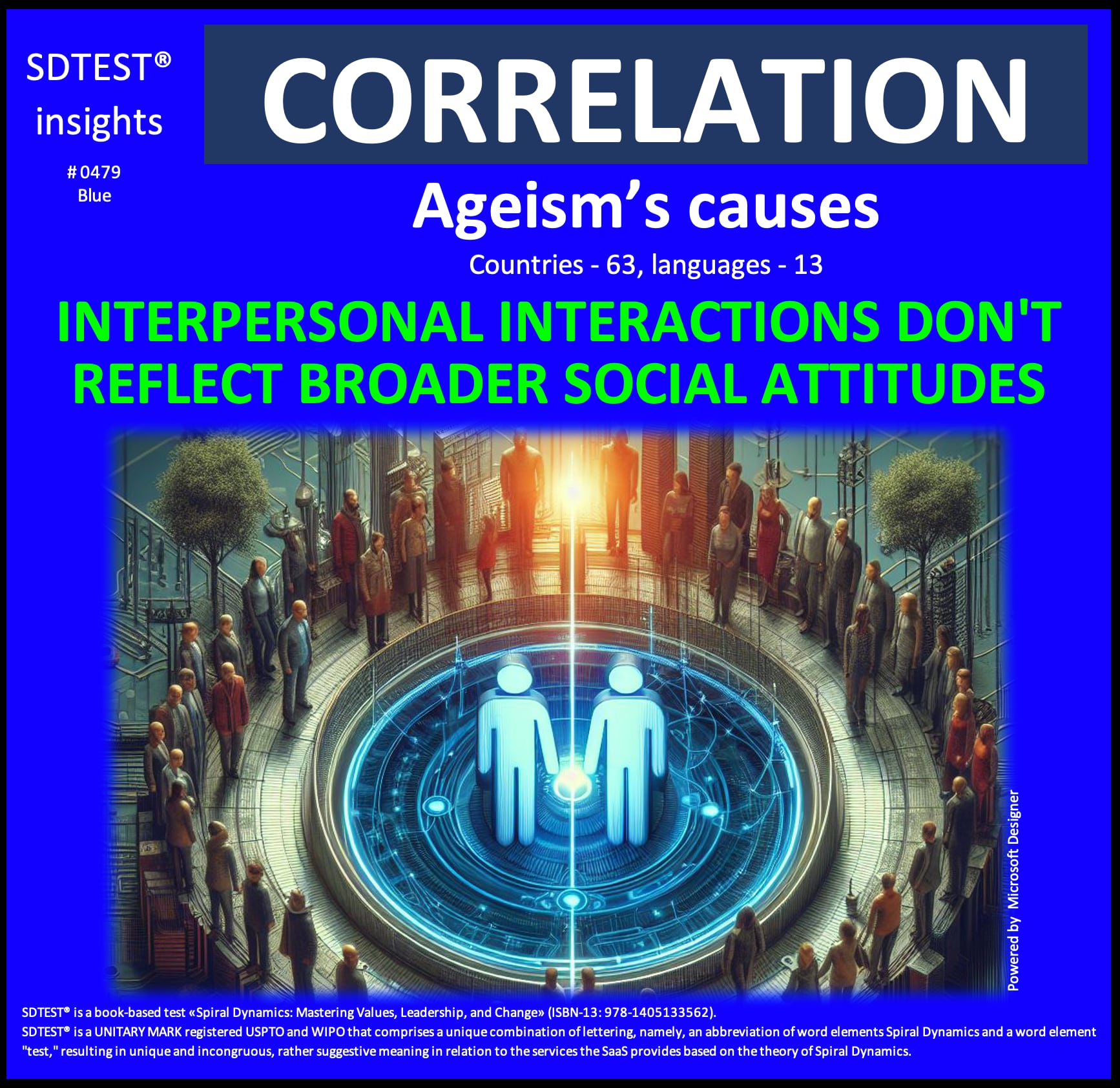
This positive correlation of 0.1410 between "No, interpersonal interactions do not reflect broader social attitudes" regarding ageism's causes and the Blue stage offers significant insights when viewed through the lens of the Blue value system:
Organizational Perspective:
Organizations operating within the Blue mindset might interpret this correlation as:
- Validation of their structured approach that separates individual behavior from broader social trends.
- Confirmation that their hierarchical systems maintain proper order regardless of changing social attitudes.
- Evidence supporting their belief that institutional rules and procedures prevent individual biases from affecting organizational conduct.
These organizations might respond by:
- Developing more comprehensive codes of conduct that explicitly address age-appropriate treatment.
- Implementing stricter enforcement of existing policies that ensure uniform treatment regardless of age.
- Promoting leadership that emphasizes duty to institutional values over shifting social attitudes.
Team Perspective:
Teams operating from a Blue mindset might approach this correlation by:
- Viewing it as an affirmation that their adherence to established protocols prevents social attitudes from infiltrating team interactions.
- Interpreting it as supporting their belief that proper team structure transcends individual biases about age.
- Seeing it as validation for their focus on roles, responsibilities, and proper chain of command over personal attitudes.
These teams might respond by:
- Engaging in more rigorous enforcement of team protocols that dictate proper treatment of all members.
- Encouraging team members to focus on position and qualification rather than personal characteristics like age.
- Celebrating instances where adherence to proper procedure prevented bias from affecting team decisions.
Individual Perspective:
Individuals aligned with the Blue value system might interpret this correlation as:
- Personal validation of their belief that following proper codes of conduct prevents personal biases from affecting behavior.
- Evidence supporting their experience that duty and discipline override personal prejudices in professional settings.
- Confirmation of the value they place on separating personal opinions from proper conduct.
These individuals might respond by:
- Actively seeking to follow established protocols in their interactions with colleagues of all ages.
- Viewing adherence to proper conduct as more important than personal feelings about age differences.
- Using organizational codes as the standard for behavior rather than prevailing social attitudes.
This correlation, viewed through the Blue lens, suggests that those operating at the Blue level believe proper order and structure override social attitudes. It implies that the Blue value system's focus on rules, duty, and authority creates a framework where proper conduct transcends changing social trends.
The reasons why interpersonal interactions might not reflect broader social attitudes about age in the Blue stage could include:
- Rule Dominance: Proper codes of conduct supersede individual attitudes about age in interpersonal interactions.
- Hierarchical Order: Established organizational hierarchies define interactions based on position rather than age.
- Duty Fulfillment: The sense of duty to follow established protocols prevents personal biases from affecting behavior.
- Institutional Loyalty: Commitment to organizational values creates consistency that transcends shifting social attitudes.
- Moral Authority: Belief in an absolute moral code provides standards for behavior that override personal prejudices.
This correlation prompts us to consider how different value systems approach the relationship between societal attitudes and interpersonal behavior. It raises questions about the potential benefits of structured systems in mitigating bias, particularly in contexts where consistent treatment is crucial for organizational function.
Ultimately, this correlation highlights the complex interplay between institutional structures, behavioral codes, and social attitudes. From a Blue perspective, proper codes of conduct serve as a buffer that prevents shifting social attitudes about age from infiltrating structured professional interactions.
In our analysis of the poll "Real freedom is," we found an intriguing negative linear correlation that warrants closer examination:
-0.1449 (Pearson) between the Achieving success and wealth through hard work and competition / Disagree strongly and the Orange stage.
The critical value of the correlation coefficient for a normal distribution, by William Sealy Gosset (Student), is r = 0.0903. Nevertheless, this negative linear correlation of -0.1449 meets the reliability criteria but does not necessarily imply causation.
This negative correlation of -0.1449 between "Real freedom is achieving success and wealth through hard work and competition / Disagree strongly," and the Orange stage offers compelling insights when viewed through the lens of the Orange value system:
Organizational Perspective:
Organizations operating within the Orange mindset might interpret this correlation as:
- Validation of their meritocratic approach that rewards measurable achievement and competitive excellence.
- Confirmation that their results-oriented culture correctly identifies success and wealth as objective measures of freedom.
- Evidence supporting their belief that market competition drives innovation, efficiency, and optimal resource allocation.
These organizations might respond by:
- Developing more sophisticated performance measurement systems to better reward high achievers.
- Implementing incentive structures that further amplify the connection between hard work and material success.
- Promoting leadership development programs focused on competitive strategy and achievement orientation.
Team Perspective:
Teams operating from an Orange mindset might approach this correlation by:
- Viewing it as an affirmation of their competitive team dynamic that drives measurable outcomes.
- Interpreting it as supporting their focus on objective results over subjective experiences or relationships.
- Seeing it as validation for prioritizing achievement-oriented team members who contribute to bottom-line success.
These teams might respond by:
- Engaging in more explicit goal-setting and performance tracking to maximize competitive advantages.
- Encouraging team members to develop strategic thinking skills that enable personal and team success.
- Celebrating instances of measurable achievement and competitive wins as evidence of effective teamwork.
Individual Perspective:
Individuals aligned with the Orange value system might interpret this correlation as:
- Personal validation of their achievement-oriented approach to career advancement and life success.
- Evidence supporting their belief that personal responsibility and strategic effort lead to deserved success.
- Confirmation of the value they place on objective measures of accomplishment over subjective well-being.
These individuals might respond by:
- Actively seeking opportunities to demonstrate their competitive edge and achievement orientation.
- Viewing their capacity to succeed through hard work as evidence of personal merit and capability.
- Using material success metrics as the primary gauge of their freedom and personal effectiveness.
This correlation, viewed through the Orange lens, suggests that those operating at the Orange level strongly associate freedom with achievement and material success. It implies that the Orange value system's focus on rationality, achievement, and competition naturally aligns with viewing freedom primarily through the lens of strategic success.
The reasons why people in the Orange stage would agree strongly with "Real freedom is achieving success and wealth through hard work and competition" could include:
- Meritocratic Worldview: Belief that freedom manifests through demonstrating superior capability in competitive environments.
- Material Measurement: Tendency to define abstract concepts like freedom through concrete, measurable outcomes like wealth.
- Strategic Agency: Perception that the capacity to strategically navigate competitive landscapes represents the highest form of freedom.
- Rational Validation: Preference for defining freedom in terms that can be objectively verified through results and achievements.
- Achievement Orientation: Intrinsic satisfaction derived from the process of setting goals, overcoming obstacles, and demonstrating success.
This correlation prompts us to consider how different value systems conceptualize freedom. It raises questions about the relationship between material success and psychological freedom, particularly in contexts where achievement orientation dominates cultural values.
Ultimately, this correlation highlights the complex interplay between societal values, personal achievement, and conceptualizations of freedom. The Orange perspective sees freedom not as an abstract right but as a concrete outcome of successful strategic action in competitive environments.
0.1019 (Pearson) between the Connect with others and the Green stage.
The critical value of the correlation coefficient for a normal distribution, by William Sealy Gosset (Student), is r = 0.0629. Nevertheless, this positive linear correlation of 0.1019 meets the reliability criteria but does not necessarily imply causation.
This positive correlation of 0.1019 between "Connect with others" as a mental health strategy and the Green stage offers meaningful insights when viewed through the lens of the Green value system:
Organizational Perspective:
Organizations operating within the Green mindset might interpret this correlation as:
- Validation of their community-centered approach that prioritizes human connection over productivity metrics.
- Confirmation that their inclusive culture correctly identifies social connection as fundamental to holistic wellbeing.
- Evidence supporting their belief that emotional and relational health underpins sustainable organizational success.
These organizations might respond by:
- Developing more sophisticated community-building initiatives that foster authentic connections among members.
- Implementing structural changes that prioritize relationship-building time alongside task-focused activities.
- Promoting leadership approaches that emphasize facilitation, emotional intelligence, and community care.
Team Perspective:
Teams operating from a Green mindset might approach this correlation by:
- Viewing it as an affirmation of their collaborative approach that values interpersonal bonds as healing.
- Interpreting it as supporting their focus on creating psychologically safe spaces for authentic sharing.
- Seeing it as validation for prioritizing team cohesion and mutual support over competitive achievement.
These teams might respond by:
- Engaging in more intentional check-ins and relationship-building practices within team structures.
- Encouraging team members to share vulnerabilities and personal challenges in appropriate contexts.
- Celebrating instances where team connection helped members navigate mental health difficulties.
Individual Perspective:
Individuals aligned with the Green value system might interpret this correlation as:
- Personal validation of their belief that healing occurs primarily in relationship rather than in isolation.
- Evidence supporting their experience that social connection provides essential emotional nourishment.
- Confirmation of the value they place on authentic relationships as central to personal wellbeing.
These individuals might respond by:
- Actively creating opportunities for meaningful connection with diverse members of their communities.
- Viewing their capacity for vulnerability and authenticity as pathways to deeper mental health.
- Using relationship-building as their primary strategy for navigating emotional challenges.
This correlation, viewed through the Green lens, suggests that those operating at the Green level naturally turn to connection as a mental health strategy. It implies that the Green value system's focus on community, inclusivity, and emotional authenticity aligns perfectly with an intuitive understanding of connection as healing.
The reasons why people in the Green stage would choose to connect with others for mental health could include:
- Relational Worldview: Deep belief that humans are fundamentally interdependent beings who heal in community.
- Emotional Intelligence: Highly developed awareness of how social connection regulates the nervous system.
- Authentic Expression: Recognition that sharing one's true experience with others reduces shame and isolation.
- Community Resources: Understanding that collective wisdom offers more diverse healing perspectives than individual reflection.
- Systemic Thinking: Awareness that personal mental health is inseparable from the health of one's relational networks.
This correlation prompts us to consider how different value systems approach mental wellbeing. It raises questions about the essential role of community in psychological health, particularly in contexts where individualistic achievement is often prioritized over connection.
Ultimately, this correlation highlights the complex interplay between social systems, personal well-being, and community health. The Green perspective recognizes that mental health is not merely an individual responsibility but emerges from the quality of our connections with others and our broader communities.
In our analysis of the poll "What makes people successful at work?" we found an intriguing positive linear correlation that warrants closer examination:
0.0540 (Pearson) between the Adaptability to change and the Yellow stage.
The critical value of the correlation coefficient for a normal distribution, by William Sealy Gosset (Student), is r = 0.0375. Nevertheless, this positive linear correlation of 0.0540 meets the reliability criteria but does not necessarily imply causation.
This positive correlation of 0.0540 between "Adaptability to change" as a work success factor and the Yellow stage offers fascinating insights when viewed through the lens of the Yellow value system:
Organizational Perspective:
Organizations operating within the Yellow mindset might interpret this correlation as:
- Validation of their systems-oriented approach that recognizes adaptability as a meta-capability transcending specific skills.
- Confirmation that their integrative perspective correctly identifies responsiveness to emergent conditions as fundamental to organizational thriving.
- Evidence supporting their belief that organizations function as complex adaptive systems rather than mechanistic structures.
These organizations might respond by:
- Developing more sophisticated learning architectures that build adaptive capacity across multiple dimensions.
- Implementing flexible structures that can reconfigure rapidly in response to changing conditions.
- Promoting leadership approaches that emphasize pattern recognition, systems thinking, and evolutionary stewardship.
Team Perspective:
Teams operating from a Yellow mindset might approach this correlation by:
- Viewing it as an affirmation of their emphasis on cognitive diversity and perspective-taking as foundations for adaptability.
- Interpreting it as supporting their focus on developing team capacities rather than static skill sets.
- Seeing it as validation for prioritizing emergent strategy over rigid planning frameworks.
These teams might respond by:
- Engaging in more deliberate practice of adaptive thinking through scenario exploration and rapid prototyping.
- Encouraging team members to develop comfort with ambiguity and complexity as core professional competencies.
- Celebrating instances where adaptive responses to unexpected challenges led to innovative breakthroughs.
Individual Perspective:
Individuals aligned with the Yellow value system might interpret this correlation as:
- Personal validation of their developmental approach that values cognitive flexibility and integrative thinking.
- Evidence supporting their experience that success comes from responding intelligently to changing contexts.
- Confirmation of the value they place on continuous learning and perspective expansion.
These individuals might respond by:
- Actively seeking opportunities to develop adaptability through exposure to diverse challenges.
- Viewing their capacity to integrate multiple perspectives as a crucial professional advantage.
- Using adaptive challenges as opportunities for personal growth rather than merely technical problem-solving.
This correlation, viewed through the Yellow lens, suggests that those operating at the Yellow level naturally recognize adaptability as central to success. It implies that the Yellow value system's focus on integration, complexity, and systemic thinking aligns perfectly with the demands of rapidly changing work environments.
The reasons why adaptability to change might be seen as crucial for work success in the Yellow stage could include:
- Systemic Awareness: Recognition that work environments function as complex adaptive systems requiring continuous responsive adjustment.
- Integration Capability: The ability to synthesize insights across diverse domains enables more effective navigation of novel situations.
- Developmental Perspective: Understanding that adaptation is not merely behavioral flexibility but a developmental capacity.
- Complexity Navigation: Comfort with ambiguity and paradox allows for effective functioning in increasingly complex contexts.
- Evolutionary Purpose: Alignment with the evolutionary trajectory of work systems toward greater complexity and integration.
This correlation prompts us to consider how different value systems approach professional success. It raises questions about the relationship between developmental stage and adaptive capacity, particularly in contexts where work environments are characterized by increasing volatility and complexity.
Ultimately, this correlation highlights the complex interplay between individual development, team dynamics, and organizational evolution. The Yellow perspective recognizes adaptability not merely as a tactical skill but as a fundamental orientation toward continuous learning and integration across increasingly complex systems.
In our analysis of the poll "Oxford Happiness Survey," we found an intriguing positive linear correlation that warrants closer examination:
0.1575 (Pearson) between the I feel that life is very rewarding / Strongly Agree and the Turquoise stage.
The critical value of the correlation coefficient for a normal distribution, by William Sealy Gosset (Student), is r = 0.0509. Nevertheless, this positive linear correlation of 0.1575 meets the reliability criteria but does not necessarily imply causation.
This positive correlation of 0.1575 between "I feel that life is very rewarding / Strongly Agree" and the Turquoise stage offers profound insights when viewed through the lens of the Turquoise value system:
Organizational Perspective:
Organizations operating within the Turquoise mindset might interpret this correlation as:
- Validation of their holistic approach that recognizes fulfillment emerges from serving the well-being of all living systems.
- Confirmation that their integrative perspective correctly identifies meaningful contribution to planetary evolution as deeply rewarding.
- Evidence supporting their belief that organizational purpose aligned with cosmic evolution creates profound satisfaction.
These organizations might respond by:
- Developing more sophisticated frameworks for connecting daily operations to global evolutionary processes.
- Implementing structures that nurture holistic wellbeing across ecological, social, and spiritual dimensions.
- Promoting leadership approaches that emphasize serving life's evolutionary unfolding at all scales.
Team Perspective:
Teams operating from a Turquoise mindset might approach this correlation by:
- Viewing it as affirmation that their work toward planetary healing creates intrinsic fulfillment.
- Interpreting it as supporting their experience that collaborative consciousness accesses deeper sources of meaning.
- Seeing it as validation for creating spaces where contribution to life's evolutionary journey is explicitly celebrated.
These teams might respond by:
- Engaging in more intentional practices that connect team activities to larger evolutionary currents.
- Encouraging team members to develop awareness of how their work serves life's unfolding complexity.
- Celebrating instances where collective consciousness accessed wisdom beyond individual capacities.
Individual Perspective:
Individuals aligned with the Turquoise value system might interpret this correlation as:
- Personal validation of their experience that sensing interconnection with all life creates profound fulfillment.
- Evidence supporting their understanding that serving evolutionary processes provides deeper rewards than personal achievement.
- Confirmation of the value they place on spiritual connection to the living cosmos as a source of meaning.
These individuals might respond by:
- Actively cultivating awareness of their embeddedness in the larger web of life.
- Viewing their capacity for experiencing unity consciousness as a gateway to deeper fulfillment.
- Using synchronicities and flow states as guidance for aligning with evolutionary currents.
This correlation, viewed through the Turquoise lens, suggests that those operating at the Turquoise level experience life as profoundly rewarding. It implies that the Turquoise value system's focus on holistic integration, cosmic interconnection, and evolutionary service aligns with accessing deeper layers of fulfillment and meaning.
The reasons why people in the Turquoise stage would feel that life is very rewarding could include:
- Cosmic Connection: Direct experience of unity with all life creates a profound sense of belonging and meaning.
- Evolutionary Service: Aligning personal purpose with life's larger evolutionary trajectory provides deep fulfillment.
- Integrative Awareness: The capacity to hold multiple perspectives simultaneously enables appreciation of life's complexity.
- Transpersonal Identity: Experiencing self as both unique and universally connected dissolves existential alienation.
- Flow Consciousness: Frequent access to states of timeless presence and synchronicity enhances life satisfaction.
This correlation prompts us to consider how different value systems approach life satisfaction. It raises questions about the relationship between consciousness development and experienced fulfillment, particularly in contexts where conventional measures of success may feel increasingly hollow.
Ultimately, this correlation highlights the complex interplay between consciousness evolution, life meaning, and experienced well-being. The Turquoise perspective recognizes that profound reward comes not from what one achieves or possesses, but from one's lived experience of interconnection with and service to the evolving web of life.
What insights do you gain from today's correlation? How might we study this relationship more carefully before deducing causation?
We welcome respectful and wise perspectives! Stay tuned every week as we share more results and insights.
After login or registration, free access to the poll results in the FAQ section.
2025.04.27
FearpersonqualitiesprojectorganizationalstructureRACIresponsibilitymatrixCritical ChainProject Managementfocus factorJiraempathyleadersbossGermanyChinaPolicyUkraineRussiawarvolatilityuncertaintycomplexityambiguityVUCArelocatejobproblemcountryreasongive upobjectivekeyresultmathematicalpsychologyMBTIHR metricsstandardDEIcorrelationriskscoringmodelGame TheoryPrisoner's Dilemma
Valerii Kosenko
Produktägare SaaS SDTEST®
Valerii utbildades till socialpedagog-psykolog 1993 och har sedan dess tillämpat sina kunskaper inom projektledning.
Valerii tog en magisterexamen och projekt- och programledarexamen 2013. Under masterprogrammet blev han bekant med Project Roadmap (GPM Deutsche Gesellschaft für Projektmanagement e. V.) och Spiral Dynamics.
Valerii är författaren till att utforska osäkerheten i V.U.C.A. koncept med Spiral Dynamics och matematisk statistik i psykologi, och 38 internationella undersökningar.




